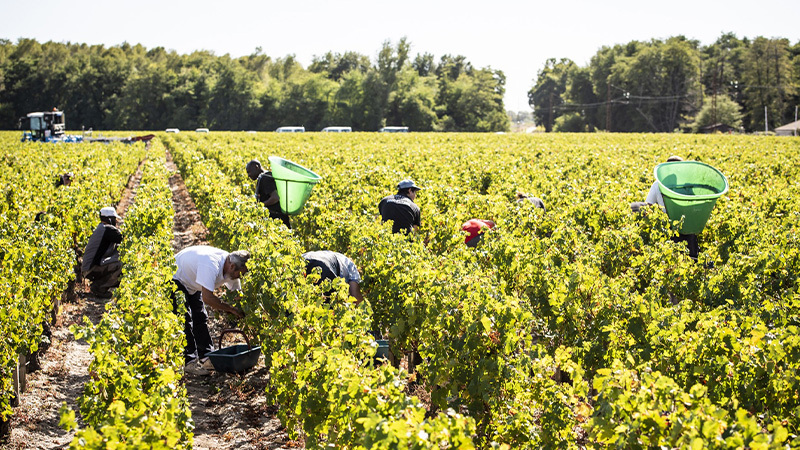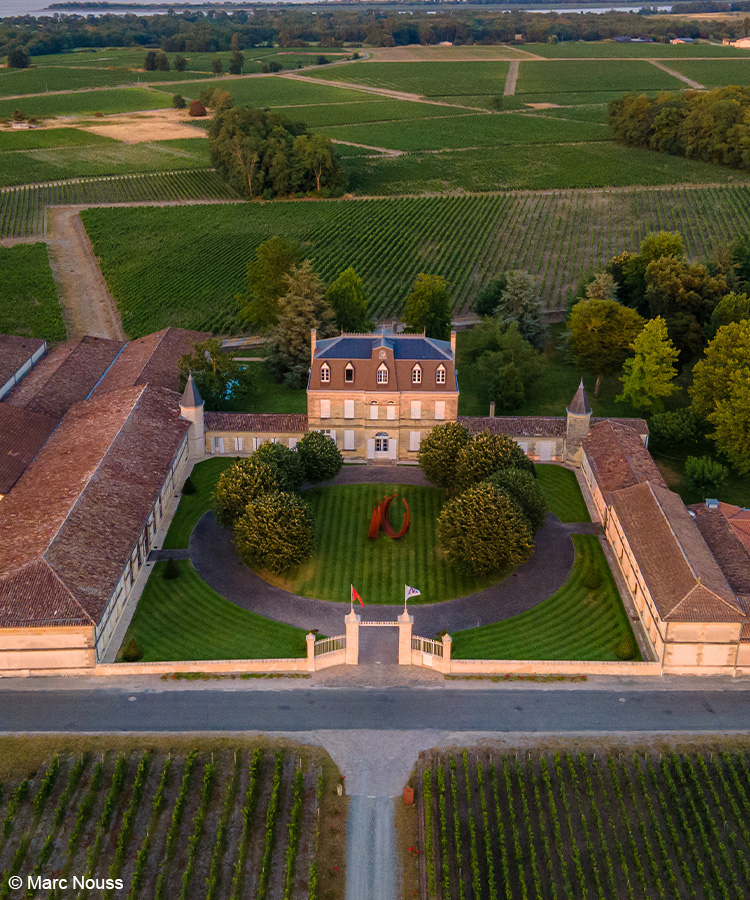
In the Bordeaux region of Médoc, surprises hide in plain sight. In addition to producing some of the most sought-after and iconic wines in the world, the Médoc offers a wealth of ready-to-drink hidden gems from small family producers who have been making wine for generations. The Médoc is also a leader among French wine-producing regions for its forward-thinking practices on sustainability — resulting in some incredible organic and biodynamic bottles — and adaptation to a changing world.

In southwest France, the Médoc peninsula sits on the left bank of Bordeaux’s Gironde estuary, where cool ocean breezes blow in from the Atlantic, and the Landes Forest borders its southeast. Médoc’s famous gravel soils (as well as some clay, limestone, and sandy soils) contribute to its terroir. The result is a region producing some of the most sought-after red wines made from blends of mostly Cabernet Sauvignon and Merlot.
The 600 châteaux in Médoc produce 80 million bottles of wine annually, and account for about 40 percent of Bordeaux red wine exports globally. While home to some of the most prestigious wine houses, the majority of Médoc wines are affordable, approachable, food-friendly, and ready to drink.
It’s just a matter of knowing what to look for.
A Legacy of Excellence
Médoc’s history of great wines extends back to the Middle Ages when the colloquial term “Crus Bourgeois” was established to denote wines of incredible quality. The region’s most famous crus were designated by Napoléon III during the Classification of 1855, resulting in an established hierarchy of wines that exists to this day.
Historically, the “Crus Bourgeois” represents the heart of Médoc winemaking; Bordeaux families received tax relief on their wines and were able to acquire the best vineyards. Meanwhile, the term “Crus Artisans” was established 150 years ago and reflects the small family vineyards that control the entire chain of production, from winemaking to packaging to sales.

There are also around 400 growers who belong to six cooperatives, representing almost half of the region’s viticultural population. Additionally, many owner winemakers have chosen not to belong to any classification, even though their wines may have the characteristics to qualify. They prefer tasters to be guided by their own judgment and sensations.
Get to Know Médoc’s AOCs
Within Médoc, there are eight Appellations d’Origine Contrôlée (AOCs), think of American AVAs but with stricter guidelines, each with their own distinct character. Two are regional AOCs — Médoc and Haut-Médoc. The other six are communal AOCs, meaning they produce wine in smaller, specific areas: Listrac-Médoc, Moulis-en-Médoc, Margaux, Saint-Julien, Pauillac, and Saint-Estèphe.
Médoc AOC
The Médoc AOC has the most vines planted and an array of soils and terroirs, resulting in diverse expressions that please a multitude of palates. Wines from this AOC are often intense, powerful, and elegant; they are approachable without aging. When they are aged, one can expect aromas of licorice, dark fruit, black cherry, and rich earth.
Haut-Médoc AOC
The longest area of the Médoc, stretching more than 37 miles north to south, the Haut-Médoc AOC has the most varied terroir in the region. Wines generally share the same characteristics: expressive and fruity with delicate and juicy tannins on the palate. These wines can be enjoyed immediately or cellared for a decade to allow for their full expression.
Listrac-Médoc and Moulis-en-Médoc
Two smaller AOCs in the western part of the region — Listrac-Médoc and Moulis-en-Médoc — benefit from a cool Atlantic climate but express that climate in different ways. Listrac-Médoc sits at the highest elevation and is home to the oldest vineyards in Médoc. In that area, the majority of grapes grown in the clay/limestone soil are Merlot, producing blended wines that are rounder, juicier, and easy to drink young. In Moulis-en-Médoc, Cabernet Sauvignon grown in gravelly soil creates wines that are bolder, more structured, and designed to age beautifully.
Margaux
Margaux is the largest and southernmost communal AOC of the bunch, spread across five villages; it has 21 wineries designated Grands Crus Classés, highly sought-after classified growth wines. Warmer, gravelly soil is perfect for Cabernet Sauvignon. These wines are marked by a delicate nose, full of finesse and intensity, and by silky tannins.
Saint-Julien and Pauillac
Saint-Julien and Pauillac are known for their Cabernet Sauvignon-based blends. There, almost 90 percent of the growing area belongs to Grands Crus Classés. The wines have aromas with a very pronounced personality that offers a remarkable palette of cedar and black fruits. They tend to be richer in Pauillac and smoother in Saint-Julien. These powerful, complex wines should be kept in the cellar for a few years to allow their full potential to develop.
Saint-Estèphe
The northernmost of Médoc’s AOCs, gravel and clay soil in Saint-Estèphe produces full-bodied wines with expressive aromas. Wines are marked by their power and structure and hold up extremely well to long periods of cellaring. You’ll want to forget about these wines for a few years before enjoying them — they’re worth the wait.
Making Wine for a Changing World

While wine grapes have been cultivated in Médoc since the 14th century, and wine-making stems from a rich, centuries-old tradition, wineries in this region are remarkably forward-thinking in their philosophies. A younger generation including more and more women, as well as a new crop of winemakers from outside of the region, are investing in smaller châteaux, and are deeply committed to sustainable agriculture. More than 91 percent of the region’s vineyards are cultivated according to environmentally-sound practices.
To adapt to a changing climate, growers are shifting how they manage their crops. They’re pruning later to protect against frost and evolving canopy management to protect grapes from the sun during heat waves. To ensure healthy vines in an increasingly water-scarce world, vineyards are turning to drought-resistant rootstock for new plantings. For more environmentally sound land management, growers are utilizing natural fertilizers for their vines.
Plus, with a landscape that encompasses beaches, pine forests, marshes, vineyards, and more, Médoc teems with biodiversity, one that will thrive in years to come thanks to the region’s commitment to its environment. For your chance to witness progress in action, drop by one of Médoc’s estates — most of them are open to the public without an appointment.
A Destination Full of Natural Wonders

The Médoc is officially recognized as a Regional Nature Park, a designation awarded by the French government to areas rich in natural, cultural, architectural, and landscape heritage. The peninsula has endless beaches to explore with year-round surfing. The Landes de Gascogne forest offers camping, hiking, and more — if you can tear yourself away from the restaurants and tasting rooms that characterize the unforgettable region. Even if you aren’t planning a trip to France any time soon, you can still experience Médoc by simply uncorking a bottle from the region.
This article is sponsored by Médoc Wines.
